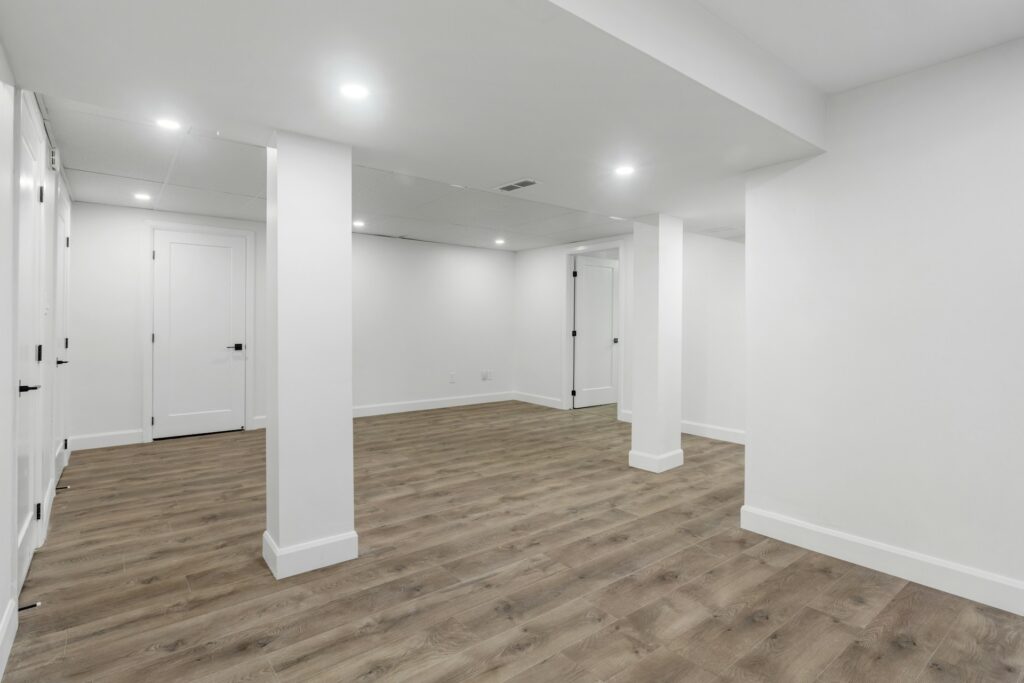Understanding Basement Moisture and Its Effects
Moisture intrusion is more than an annoyance. It’s a critical factor that can affect the longevity and safety of your home. Dampness in basements isn’t always noticeable; it can quietly permeate through concrete, infiltrating the stability of a home’s foundation. There are many ways that moisture can accumulate in basements, from the external hydrostatic pressure exerted by wet soil to condensation brought about by differences in temperature and humidity indoors versus outdoors. Internal sources are not underestimated; leaking pipes and appliances contribute to moisture levels. These issues can lead to costly and complex structural problems if not addressed promptly.
Moisture accumulation can be insidious, often starting undetected before escalating into a noteworthy problem. The science of moisture migration involves understanding how water moves through various materials due to hydrostatic pressure, capillary action, or diffusion. Temperature gradients can also cause condensation to form on more excellent surfaces in the basement. Ventilation, or the lack thereof, plays a significant role as well. A poorly ventilated basement can lead to stagnant air, creating a moisture-laden environment conducive to the problems we wish to avoid.
Various elements can contribute to a home’s humidity. Exterior issues like gutter overflow, ineffective drainage, or land grading that directs water toward the foundation are common culprits. Internal sources range from daily activities like showering and cooking, which release moisture into the air, to malfunctioning HVAC systems. Over time, unchecked humidity can seep into the basement’s pores, causing dampness and leading to more significant issues if not rectified.
In the long run, a moisture-laden basement can become a liability. The environment becomes hospitable for mold and mildew growth, creating health risks and unpleasant odors. Also, persistent dampness can lead to rot and deteriorating carpets, furniture, and stored items. It’s important to remember that preventing moisture issues is better than trying to fix them later. Measures like basement waterproofing in Staten Island can preempt these pervasive problems and safeguard your home against unchecked water damage.
The Basics of Basement Waterproofing
Basement waterproofing is the collective defense against water ingress into your home’s lowest level. The term encompasses a variety of methods and procedures, each aimed at diverting water from the basement. It can include simple sealants applied to interior walls, more complex exterior waterproofing membranes that wrap around the foundation, or strategically placed drainage systems that manage water at the source, preventing it from ever reaching the vulnerable points of a home.
Effective waterproofing is not a one-size-fits-all solution. Interior sealants, for example, can manage minor dampness but might not stand up to significant water pressure. Exterior coatings, on the other hand, provide a more robust barrier, protecting the very fabric of the building. Then, there’s the integration of drainage systems, such as French drains and sump pumps, designed to address water at its origin, diverting it safely from home. Each technique has pros and cons, and the appropriate choice heavily depends on the property’s unique circumstances and the extent of the moisture issues.
When deciding to embark on waterproofing, weighing various considerations is essential. What are the typical moisture levels in your area? Is your basement finished or unfinished? What type of soil surrounds your home? These questions can affect the choice of methods and materials for waterproofing. It’s also necessary to consider the underlying causes of your basement moisture problem to ensure that whatever solution you select addresses the root of the issue, not just its symptoms.
Waterproofing Materials and Techniques
Bituminous coatings and PVC membranes have been stalwarts in waterproofing for years. Their application to the exterior of foundations has been proven to resist water penetration effectively. However, newer, more advanced solutions continuously supplement the traditional materials.
Recent innovations in waterproofing technology offer a range of benefits. For example, elastomeric polymers stretch, accommodating the natural shifts and cracks of a home’s foundation, while crystalline waterproofing applications create a chemical reaction that fills the capillaries within the concrete to block water. These and other cutting-edge materials present an upgraded arsenal against moisture intrusion.
A DIY approach can be taken for minor leaks or dampness issues with many products available in local hardware stores. Yet, it’s essential to recognize when a job exceeds your expertise. Professional waterproofing companies have the experience, equipment, and mastery of techniques required for larger, more intricate jobs. It ensures a longer-lasting and more reliable solution than most DIY attempts can offer.
The Role of Proper Drainage in Moisture Control
Managing water away from the foundation is a cornerstone of basement moisture control. Exterior drainage systems include properly sloped landscaping, gutter systems directing water away from the house, and subsurface drains. Interior solutions, such as perimeter drains inside the basement and sump pumps, mitigate any water that can intrude, maintaining a dry basement environment.
A sump pump is often a key fixture in a well-designed basement waterproofing system. It collects water in a basin usually positioned at the basement’s lowest point and pumps it out and away from the house, keeping it dry even during heavy rains. However, reliability is critical; routine inspections and maintenance help ensure that, when needed, your sump pump is fully operational and ready to protect your basement from flooding.
Detecting Early Signs Of Basement Water Issues
A proactive approach to maintaining a dry basement involves being alert for the signs of moisture problems. Such signs include water stains on walls and floors, efflorescence(a white, powdery substance left by evaporating water), and warped wood materials. By identifying and resolving early warning indicators, little problems can be kept from growing into significant obstacles.
Regularly inspecting your basement for any irregularities is critical in water damage prevention. Homeowners should watch for any new or expanding cracks in the foundation, ensure window wells are clear of debris, check for signs of moisture after heavy rains, and maintain sump pumps and other waterproofing systems to avoid potential failures.
Health Risks Associated with Basement Dampness
Damp basements are prime breeding grounds for mold and other allergens. Mold does not only affect the structural elements of the house but also poses several health risks. The Centers for Disease Control and Prevention (CDC) strongly advises that those without asthma will likely experience allergic reactions or respiratory issues. In contrast, individuals with asthma are highly susceptible to experiencing a worsening of symptoms. Ensuring your basement remains dry is not just about preventing property damage; it’s also about protecting the health and well-being of your family.
Finding telltale indicators of mold growth in your basement entails looking for musty odors, discolored carpet patches, and dark patches on the walls. As soon as mold is found, it is imperative to eradicate it and deal with the moisture source that first enabled it to grow. When the situation is severe, contacting a mold remediation agency will help you determine the exact amount of the infestation and take the necessary steps to address it.
Legal Aspects and Building Codes in Waterproofing
Navigating the legalities surrounding home improvements can take time and effort. Variations in building codes and regulations between locales mean that solutions suitable for one area may need to be more compliant in another. Homeowners must familiarize themselves with the specific requirements mandated in their region to ensure their waterproofing solutions conform to local construction and renovation rules.
Following building codes isn’t just about legality; it also ensures that the waterproofing measures are safe and effective. Professionals in the field are well-versed in these regulations. They can provide compliant solutions that adhere to the highest industry standards, guaranteeing that the structural integrity and safety of the home are not compromised.







